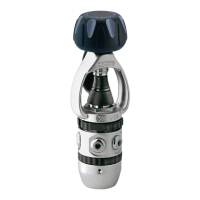pre-dive and dive (Fig. 16). In the first mode, a flow limiting device
placed in the mouthpiece inlet starts operating, and inhibits the
Venturi effect, preventing free flow. With the latter on, the Venturi
effect is able to work at its best, increasing the air flow released
by the regulator to the maximum level.
WARNING: Always remember to set the flow deflector’s
lever in PRE-DIVE (-) mode when not using the regulator; oth-
erwise, an accidental collision, the regulator falling into water,
pressing the manual regulation button without having the
mouthpiece in one’s mouth, or suddenly taking the regulator
out of the mouth might trigger a strong free flow, causing high
air consumption.
When the diver exhales, he causes the pressure inside the case
to increase and open the discharge valve. This valve, with a com-
pletely new design and specially calibrated dimensions, is conical
in shape to guarantee a perfect seal for the regulator under all
conditions and all positions during use. In addition, the second
stage case exhaling section has been designed so as to offer the
best performance in combination with the exhaling baffle.
The latter, which can be taken out of the case by means of a spe-
cial sliding hook, directs all exhaled air away from the diver’s face,
thanks to a partition placed on its centre which presses the dis-
charge valve in its middle section ensuring that it opens in an ex-
tremely controlled way. This way, the regulator's exhaling
performance is optimized while also protecting the valve from tur-
bulence in the water that might otherwise open it when the inside
of the case is not pressurized, leading to flooding.
The second stage is connected to one of the 3/8” LP ports on
the first stage by means of an extremely light and flexible
medium-pressure hose, made of a state-of-the-art thermoplastic
material that is extremely durable, lightweight, and with excellent
flow capacity.
68
SECOND STAGES
fig. 18
fig. 19
fig. 17
PRE-DIVE
DIVE

